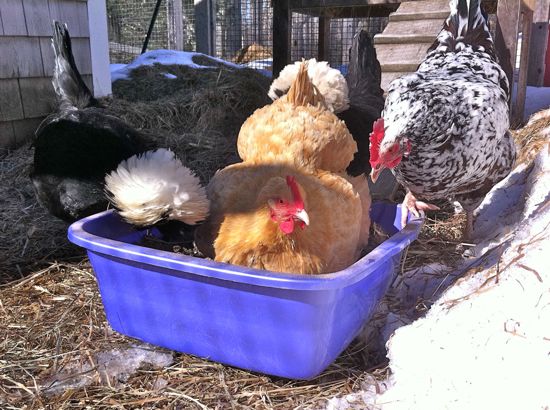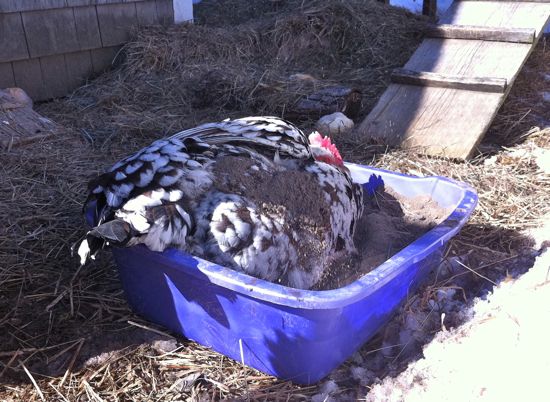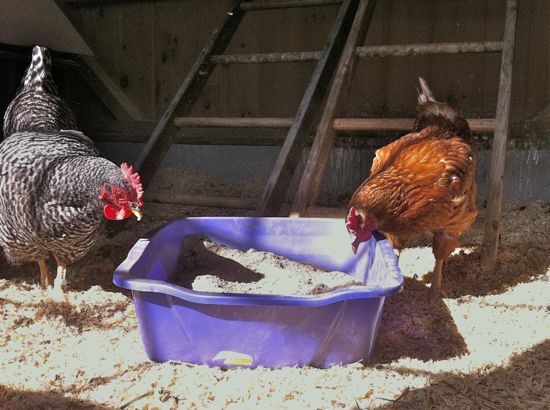Chickens require dust baths for health and happiness. But, right now it’s 20º colder than usual for early March, there’s 18 inches of snow under the bushes where they usually take late winter dust baths, and there’s several feet of snow in their run. There’s no dirt, let alone loose, warm earth to get under their feathers and next to their skin to kill parasites.
So, I went to K-Mart and purchased two kitty litter pans, and filled them with sand, fireplace ashes (all hardwoods) and food-grade diatomaceous earth. There’s a spot of sun in the HenCam run, so I set one down there. You know who’s on the top of the pecking order by who gets the first bath.
Buffy settled right in.
Next it was Lulu’s turn. Notice the dirt that she’s kicked up onto her feathers. She’s about to fluff and ruffle and have it settle onto her skin. Chicken bliss.
The Big Barn has plenty of room inside for the dust bath, and there’s sun streaming in the window. Just the right place for their new spa. The girls are wary of the bin, but I’ve tossed in some corn. They’ll soon be sun-bathing, too.
I wish that spa treatments for myself were so inexpensive and easy!




Very good idea. They look so happy. We covered part of our run. It shades the sun in the summer and keepssnow out in the winter. They have bathed a large hole that I fill up once a week with peat moss. What we do to keep happy chickens. I would not have it any other way. What joy they give us and eggs too!!! Nice eggs that we now all steam to perfection!
Can you tell me what does the ash component to the “spa” mix do? I know the diatomaceous earth will kill the parasites, and the sand really serves as an abrasive and base, but what about the ash?
The ash isn’t necessary, but they love it. It’s the right consistency – powdery. I imagine it has some cleansing properties, too, but I don’t have proof.
Do your girls fish out the little bits of charred wood and eat them?
Since I started giving them a spa like yours, they’ve been eating charcoal which makes for freaky black poops. But I’m assuming that if they choose to eat it, it must have some health qualities…?
I’m assuming it’s like charcoal dog biscuits.
Wood ash use to be used in making lye soap. So Terry is correct again it has cleaning properties.
I always put my ashes from the fireplace in the flower beds and when the girls get to run around the yard (under my watchful eyes, too many hawks) they seek out the flower beds with the fresh wood ashes.
Hens dust bathing is pure happiness.
What a life ! I want to be a Golson hen !
Since I can’t get to our compost bin I have been burning the egg shells in the woodstove. The hens go crazy looking for the little pieces while they “bathe”! & a great way to get some additional calcium.
Great idea!
Hi Terry,
I’m curious, I’ve seen Candy in the henhouse (so cute). Do the hens ever go into her hutch? Does she naturally put herself in the hutch at dusk or do you need to put her in?
Thank you for all the info you share and your wonderful site.
Candy does not let the hens in her hutch. I’ve actually seen her bare her teeth! She’d rather not be closed in at night, but she’ll do anything for her nightly banana chips.
Ahh, looks like the Polish are at the bottom of the pecking order. How did Buffy end up to be the top hen, is it just age ?
It’s personality! It’s not even the most aggressive. Leadership qualities, you might say :)
Sweet. I love that Buffy has the right leadership qualities. I love that bossiness doesn’t win out. Same with my flock.
I think they are in awe of her voluptuous feathers.
I give my girls spa’s too. I love the way you treat your animals. Have you ever read the book Kinship With All Life by J. Allen Boone?
I recently visited a” free range” farm. I was appalled! There were 2 pens of 250 birds. Their beaks were cropped the air was dusty and there was a loud hum of stress. I’m so thankful that some of us can treat our animals well. I’m on a mission to help improve the lives of these birds. I’ve asked if I can do a free presentation on back yard chickens(.Your site is on my resource list). And I’ve also asked if I can speak with the head farmer. With just a few changes their lives could be so much more pleasurable. Thanks Terri for your superb example!
Gail
Many farmers mistakenly believe that beaks have to be trimmed to prevent cannibalism. If the animals are fed properly and given enough room, pecking shouldn’t be an issue. (There are some lines of chickens that are more aggressive. You need to avoid those, too.) 250 birds is a very small flock for a commercial operation. I’ve seen houses with 30,000. It CAN be done right, but sadly, rarely is.
Aaaaaaaah. I can almost feel that dust in my feathers….!
Oh gosh, I’m going right out and filling my spare litter box with some of the dusty, sandy soil under the eaves that the girls used to head for when I was letting them out to destroy my garden! Why didn’t I think of using a plastic box before? Great idea.
On the chicken aggression issue, I have a question for you. My little flock has had some pecking going on, the worst towards my sole bantam. As a newbie chicken rancher (April of last year) I didn’t fully understand the immutability of ‘pecking order’ and I have been trying various things to help little Babe out. Winter was just a bit more confining and claustrophobic for the girls than I had expected. Flock block, hanging cabbages and a separate, semi-private nest box for the little one has helped. I am going to build a second, bigger run this spring, as soon as the ground thaws for digging postholes.
For future chick replenishment, could you list your favorite breeds for friendlier/non- aggressiveness? My worst hen is some kind of ungodly mutt that was mislabeled as a Plymouth Columbian Rock, but instead seems instead to be a silver-laced something or other. She has been a bitch from the first. She pecks everyone, including me, and is a complete bully when it comes to grabbing food out of everyone else’s beaks, and pecking poor little Babe.
When I mentioned this to the guy at the feed store where I bought her, he said, “oh, THOSE chicks. They were all like that. We had a terrible time with them. They all pecked each other like crazy. We will never order them again.” which made me feel a bit better. Anyway, I am considering giving her away to someone with a larger, free-ranging flock, and eventually replacing her with a different breed. Suggestions?
I had one girl that started to jump on the back of another and peck her head and draw blood and she started sneeking up behide me to peck my legs. When I caught her doing it I picked her up and very gently held her upside down by her legs for a few seconds. She went limp and calm. Then I very gently turned her back up and held her and stroked her and told her in a very loving voice that she is a sweet girl and a nice girl. She stayed calm and closed her eyes for a few minutes before I put her down. I repeated this the next time I saw the same behavior and that did the trick. This time love conquered all but I did catch it before it was a strong habit.
I hear that that technique can work with some – but not all – roosters. Pecking at heads is a lethal habit. I’m glad you caught it in time! Often, you don’t know the aggressor until after she’s already succeeded in killing several hens.
Vicki, do you have a rooster? I suspect your hen is taking the rooster role. Sounds like the hen is mounting the other hen in a mating ritual. I lost my rooster to a hawk a couple months ago and a hen in my flock has taken on the rooster role. I’ve seen her mount several hens. She is still laying too. I have a rooster coming in my order of chicks set to arrive on the 14th of this month. Yeah!!!
I have had roosters in the past attack me, I obviously don’t tolerate it. What I do is chase them around, catch them and do the holding upside down method. If that don’t work, I chase them and then GENTLY give them a soccer type lift. Get my foot under them and toss them in the air, not high mind you. This demonstrates my superior strength and if the first method doesn’t work this one does. If these two fail it’s time for a Sunday dinner of chicken-n-dumplings.
Hi Ken- I’ve had all hens, no roosters, for the last fifteen years. I’ve never had a problem with a hen behaving like a rooster. I have had hens peck at other hens, and do the head pounding thing. As soon as pecking order was determined, it stopped. It also helped that I gave the picked on girls places for them to get away from the aggressors.
And for once, I don’t agree with you :) I don’t want anyone to toss roos, even gently. OTOH, I’ve no problem with aggressive roosters going in a pot!
You might have noticed on the hencam that my little hens go under the nesting boxes – it’s a safe place that the big girls can’t get to. If you construct something like that for your bantam she should be alright.
For gentle hens, you can’t go wrong with Orpingtons. I’ve also really enjoyed the NH and RI Reds. Dorkings are really sweet. I’m getting some new breeds (for me) this spring and I have a feeling the Delawares are going to be nice. I’ve had trouble with Wyandottes and Barred Rocks – but different lines have different personalities. I know some gentle hens of those breeds – I just didn’t get them!
Another question about the dust bath. Why ‘hardwood ashes only’? Is there something in other ash that is harmful to chickens? We have a wood-burning stove, which produces plenty of ash, but we only have access to pine and occasionally fir logs. Would that ash be harmful?
I think any wood ashes would be fine. What I worry about is when trash is burned in wood stoves. Lots of magazines are printed with nasty inks. Sometimes there’s plastic on envelopes. Part of the dust bathing routine is pecking and ingesting the dirt, so I like it to be good for them.
I think you’re supposed to avoid coal ash too, there’s some evidence that it encourages scaly leg.
On the over-dominant hen front, I find embarrassing the bully does the trick. Making sure all the other birds can see, stand over the hen and press down gently on his/her back to get it into a submissive position, as they do when preparing to mate. You’ll notice the girls do this as well when they’re in lay – mine squat as soon as they see me coming!
Hold the bully like this for a minute if you can, then pick it up and cuddle it to further embarrass it.
Do this every time you’re anywhere near it and it will soon learn that YOU are the top of the pecking order!
Hi Wendy- I don’t know anyone who burns coal here. Perhaps it’s a British thing?
re the aggressive hens – I honestly don’t think they’re trying to mate or be like roosters. I think they’re being dominant hens. Doing what you’ve said makes a lot of sense. It helps to have the hens in an enclosed area where you can catch them! For people who have a mix of bantams and larger birds, the best you can do for your small hens is to have places for them to hide – like the area under the nesting boxes that the big birds can’t reach.
I too have mix flock of bantams and larger breeds. The hiding spot is an excellant idea. In my run I also provide a roost that is about 5.5 feet off the ground. 90% of the large breeds can’t fly that high or choose not to but of course the bantams can. They love to spend time on this roost to sun, preen and rest.
Good call on the kitty-litter-bin-dust-bath! I made one for my girls yesterday, after enough snow melted for me to locate the fall-hidden box. Lucy, my most aggressive/bully hen, hopped right in and hognoided the box for the next 2 hours. How she loved it, and everyone else did too, once she let them get their beaks in for a nibble. My bantam couldn’t get over the top of the bin, so last night I added some pavers to raise the ‘ground level’ for her, and today I will add more soil. Will also head to the feedstore for some DE. My girls say thanks!
So glad it’s working for you!
What a great idea! I am happy I just figured out how to follow a blog in Google reader using its URL. (I used to think they had to have that blogger followers widget)So now I can keep up with your blog better. Thanks for all the great chicken info!